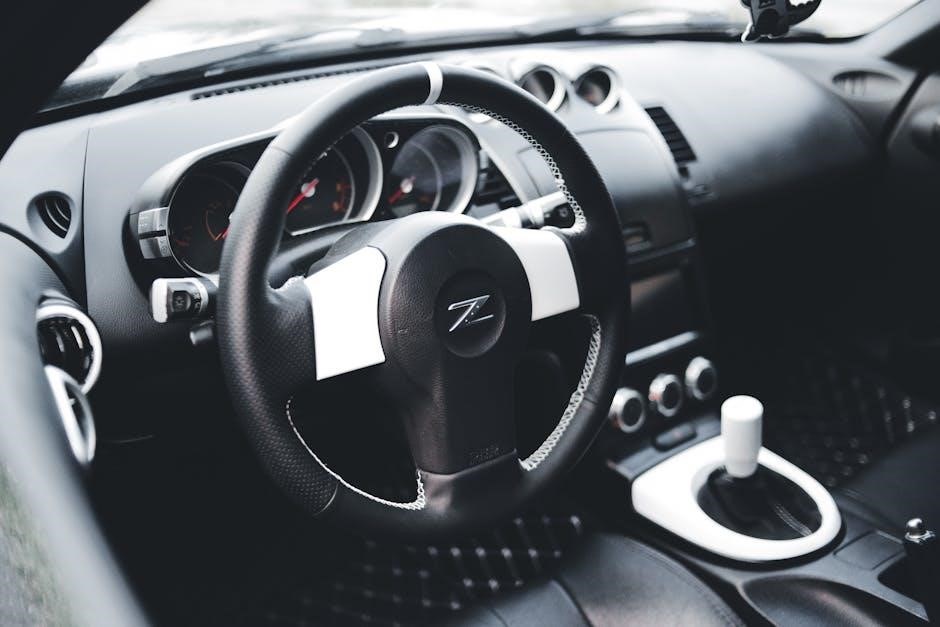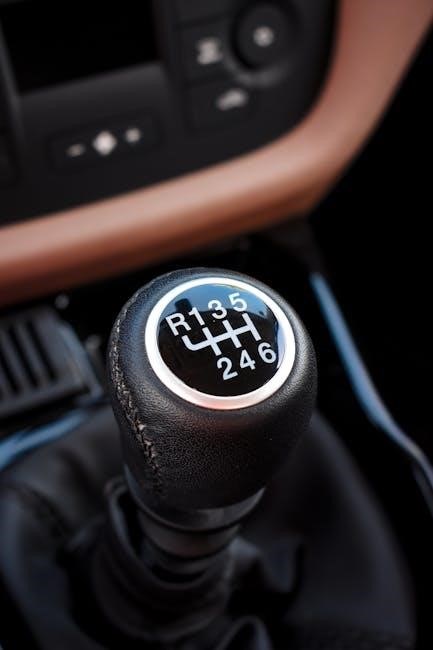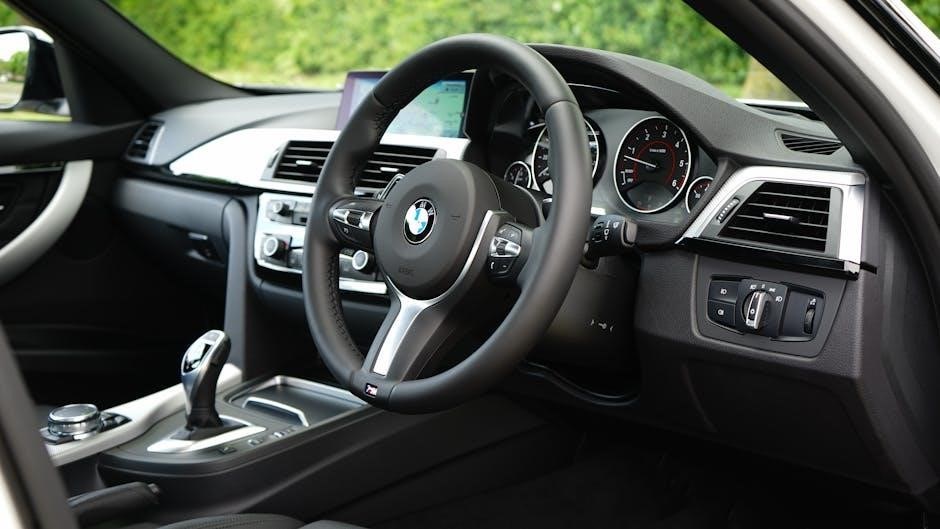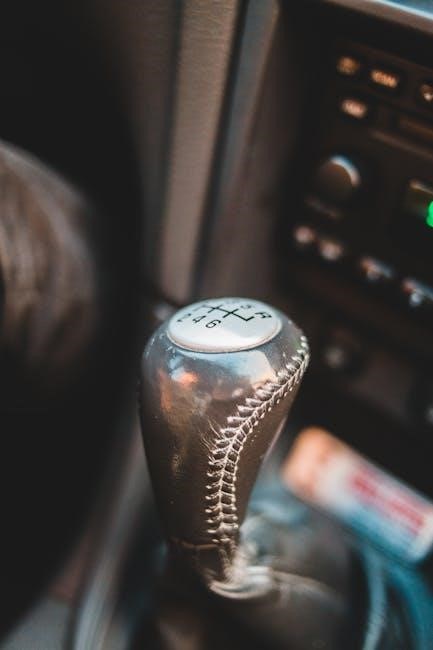A gear shift knob is a crucial component of a manual transmission system, connecting the driver to the gearbox. It enhances control, comfort, and personal style, offering various materials like leather, carbon fiber, and weighted designs for improved shifting precision and aesthetics. Available in universal and vehicle-specific models, it allows drivers to customize their driving experience, blending functionality with unique visual appeal.
1.1 Overview of Gear Shift Knobs
A gear shift knob is a component mounted on the gear lever of a manual or automatic transmission, serving as the interface for gear selection. Available in various materials like marble, leather, carbon fiber, and aluminum, these knobs offer both functionality and aesthetic appeal. Designs range from spherical to T-handle styles, with some featuring LED backlighting or weighted construction for enhanced shifting precision. Universal adapters make them compatible with multiple vehicle types, ensuring a secure fit on most gear sticks. Whether for style, comfort, or performance, gear shift knobs provide a personalized touch to the driving experience, blending practicality with unique visual and tactile characteristics.
1.2 Importance in Manual Transmissions
The gear shift knob plays a vital role in manual transmissions by providing a comfortable and secure grip, essential for precise gear changes. Its design and material significantly impact driving comfort and control, reducing fatigue during long drives. Weighted knobs enhance shifting accuracy and smoothness, while textured surfaces improve traction, preventing slippage. Customization options allow drivers to personalize their driving experience, boosting both functionality and aesthetics. Additionally, the knob’s durability ensures long-term performance, making it a key component in maintaining the overall efficiency and enjoyment of a manual transmission vehicle.
History and Evolution
The gear shift knob has evolved from simple, functional designs to modern, customizable options, reflecting advancements in materials and ergonomic trends over the years.
2.1 Early Designs and Materials
Early gear shift knobs were simple, often made from wood, Bakelite, or metal, prioritizing functionality over aesthetics. These materials provided durability and a basic grip, suitable for the mechanical demands of early manual transmissions. The designs were minimalistic, with rounded shapes and smooth surfaces, reflecting the utilitarian focus of the time. As automotive technology advanced, so did the materials, introducing plastic and rubber, which improved comfort and grip. These early designs laid the foundation for the diverse range of shift knobs available today, balancing practicality with personal style.
2.2 Modern Advancements
Modern gear shift knobs have evolved significantly, offering enhanced functionality and aesthetics. Materials like carbon fiber, aluminum, and weighted designs provide improved durability and shifting precision. LED backlighting and ergonomic shapes enhance driver comfort and visibility. Customization options, such as interchangeable patterns and adapters, allow universal fitment across various vehicles. Weighted knobs improve gear engagement accuracy, while advanced manufacturing techniques ensure a premium finish. These innovations cater to both performance-driven enthusiasts and everyday drivers, blending style with practicality. The shift knob has become a symbol of personalization, reflecting modern automotive trends toward tailored driving experiences.
Design and Materials
Modern gear shift knobs are crafted from materials like carbon fiber, aluminum, and leather, offering durability and style. Weighted designs enhance shifting precision, while ergonomic shapes and LED backlighting improve comfort and visibility. These features cater to diverse driver preferences, ensuring a personalized and efficient driving experience.
3.1 Common Materials Used
Manual transmission gear shift knobs are made from a variety of materials, each offering distinct advantages. Aluminum is popular for its lightweight and sleek appearance, while carbon fiber is favored for its high strength and modern aesthetic. Leather shift knobs provide a premium feel and improved grip, often paired with stitching for a sporty look. Plastic knobs are cost-effective and durable, commonly found in standard vehicles. Some knobs feature a combination of materials, such as a metal base with a leather or rubber wrap, enhancing both functionality and style. These materials cater to different driving preferences and vehicle interiors, ensuring versatility and customization.
3.2 Aesthetic and Functional Design Options
Manual transmission gear shift knobs offer a wide range of aesthetic and functional design options to suit individual preferences. Spherical, T-handle, and crystal resin designs provide unique visual appeal, while weighted knobs enhance shifting precision. Some feature LED backlighting or gear pattern inserts for added functionality. Textured surfaces, such as leather wraps or non-slip aluminum, improve grip and comfort. Custom designs, including emblems or engravings, allow personalization. Universal adapters enable compatibility with various vehicles, making customization accessible. These options balance style and performance, ensuring drivers can tailor their shifting experience to their lifestyle and vehicle aesthetics.

Functionality and Performance
Manual transmission gear shift knobs enhance driving experience by providing precise control over gear shifts. Weighted knobs improve shifting accuracy, while textured surfaces ensure a firm grip, reducing fatigue.
4.1 How Gear Shift Knobs Work
A gear shift knob is connected to the shift lever, allowing drivers to manually change gears in a vehicle. When the driver moves the knob, it engages or disengages gears in the transmission. The knob’s design, including its material and weight, influences the shifting mechanism. Weighted knobs provide added mass, enhancing the feel and precision of gear changes. The knob’s movement is tied to the transmission’s internal components, ensuring smooth transitions between gears. Modern designs often feature textured surfaces or ergonomic shapes for better grip and control. The functionality of the shift knob is essential for precise and efficient gear shifting in manual transmissions.
4.2 Benefits of Weighted Shift Knobs
Weighted shift knobs offer several advantages for drivers of manual transmission vehicles. The added mass improves the mechanical advantage, making gear shifts smoother and more precise. This reduces effort and fatigue during frequent shifting. Weighted knobs also enhance the tactile feedback, allowing drivers to feel each gear engagement more distinctly. Additionally, the momentum from the weight helps guide the lever into the correct gear position, reducing the likelihood of misshifts. This feature is particularly beneficial for performance driving, where quick and accurate gear changes are crucial. Overall, weighted shift knobs provide a more refined and controlled driving experience, making them a popular choice among enthusiasts and everyday drivers alike.
Installation and Customization
Installing a gear shift knob is straightforward, often requiring basic tools and adapters. Customization options include various materials, designs, and thread sizes to fit specific vehicles, enhancing both style and functionality.
5.1 Step-by-Step Installation Guide
Installing a manual transmission gear shift knob typically involves a few simple steps. First, ensure the vehicle is in neutral gear with the parking brake engaged. Next, remove the old shift knob by unscrewing it counterclockwise or pulling it straight off if it’s secured with a clip. Before installing the new knob, inspect and clean the shift lever to ensure a secure fit. Apply a small amount of silicone-based lubricant to the threads for smooth operation. Finally, screw the new shift knob clockwise until it is snug, ensuring it doesn’t come loose while driving. Proper installation ensures smooth shifting and optimal performance.
5.2 Customizing Your Shift Knob
Customizing your shift knob allows for personalization and enhanced functionality. Enthusiasts can choose from various materials like carbon fiber, leather, or aluminum for a stylish look. Some shift knobs feature LED backlighting or gear pattern inserts for added visual appeal. Weighted knobs improve shifting precision, while unique designs like skull or crystal resin knobs offer a personalized touch. Many universal shift knobs come with adapters, ensuring compatibility with most manual and automatic transmissions; Additionally, some manufacturers offer online builders to design custom knobs, allowing users to tailor the appearance and functionality to their preferences. This customization enhances both the aesthetic and ergonomic aspects of the driving experience, making it uniquely tailored to the driver’s style and vehicle.

Safety and Ergonomics
A well-designed shift knob enhances driver comfort and safety. Non-slip surfaces prevent accidental shifts, while ergonomic materials like leather or aluminum reduce fatigue. Weighted knobs improve control, ensuring precise gear engagement and a secure grip, reducing distractions during driving.
6.1 Impact on Driver Comfort
The design and material of a gear shift knob significantly influence driver comfort. A well-crafted knob with a non-slip surface ensures a secure grip, reducing fatigue during long drives. Weighted knobs provide better control, minimizing wrist strain. Ergonomic designs, such as rounded or contoured shapes, fit naturally in the hand, enhancing comfort. Materials like leather or aluminum offer a premium feel, while textured surfaces improve tactile feedback. A knob that matches the driver’s preferences can also boost confidence and reduce stress, creating a more enjoyable driving experience. Customization options, such as LED backlighting or gear pattern inserts, further enhance usability and satisfaction.
6.2 Safety Features to Consider
When selecting a gear shift knob, safety features are paramount to ensure reliable operation and prevent accidents. A secure, non-slip design prevents the knob from moving during use, maintaining consistent control. Properly threaded adapters and durable materials are essential to avoid loosening over time, which could lead to loss of control. Weighted knobs provide stability, reducing unintended gear shifts. Additionally, knobs with clear gear pattern indicators help drivers stay aware of their gear position, minimizing errors. Ensuring the knob is compatible with the vehicle’s transmission and installed correctly is critical for safe operation. Prioritizing quality and fit guarantees a safer, more reliable driving experience.

Maintenance and Replacement
Regular cleaning with a soft cloth and mild detergent keeps the shift knob free from dirt and oils. Inspect for wear or damage annually, replacing if necessary.
7.1 Cleaning and Care Tips
Regular cleaning of your manual transmission gear shift knob is essential to maintain its appearance and functionality. For leather shift knobs, use a soft cloth dampened with mild soap and water. Avoid harsh chemicals or abrasive materials that could damage the surface. For metal or carbon fiber knobs, a damp cloth is sufficient, while weighted knobs may require occasional polishing. Always dry the knob thoroughly after cleaning to prevent moisture buildup. Avoid exposing the knob to direct sunlight or extreme temperatures, as this can cause fading or material degradation. Regular maintenance ensures optimal grip and longevity of your gear shift knob.
7.2 When to Replace Your Shift Knob
Replace your manual transmission gear shift knob if it shows signs of wear, such as cracks, faded patterns, or a loose fit. A worn knob can compromise grip and shifting precision, leading to less control over gear changes. If the knob is damaged internally or externally, it may no longer function smoothly. Additionally, if the knob’s material has deteriorated, such as leather cracking or metal corroding, it’s time for a replacement. Upgrading for aesthetic or performance reasons, like switching to a weighted knob, is also a common reason. Ensuring a secure and comfortable connection to your transmission is crucial for both safety and driving enjoyment.
Trends and Innovations
Modern weighted shift knobs and illuminated designs enhance driver experience. Carbon fiber and aluminum materials are gaining popularity for durability and style. Customizable options with LED backlighting and ergonomic shapes are also trending.
8.1 Current Market Trends
The market for manual transmission gear shift knobs is evolving with a focus on customization and aesthetics. Weighted shift knobs are in high demand, offering improved shifting precision. Materials like carbon fiber and aluminum are popular for their durability and sleek designs. LED backlighting and illuminated gear patterns are trending, enhancing both functionality and style. Additionally, universal adapters are becoming standard, allowing compatibility with various vehicle makes and models. This shift reflects a growing desire for personalized driving experiences and a blend of performance with visual appeal.
8.2 Future Innovations in Shift Knob Technology
Future innovations in shift knob technology are expected to focus on smart integration and adaptive features. Haptic feedback systems could provide tactile responses during gear shifts, enhancing driver engagement. Adaptive weighting might adjust based on driving conditions, optimizing control. Additionally, eco-friendly materials and sustainable manufacturing are likely to gain prominence. Integrated displays showing gear patterns or real-time data could become standard. Connectivity with in-car systems, such as customizable illumination, could also emerge. These advancements aim to blend technology with driver preference, ensuring a seamless and personalized driving experience while maintaining performance and style.

Legal and Regulatory Considerations
Manual transmission gear shift knobs must comply with vehicle safety standards and regulations. Aftermarket parts require certification to ensure compliance and performance standards are met.
9.1 Compliance with Vehicle Standards
Ensuring compliance with vehicle standards is critical when selecting or installing a manual transmission gear shift knob. Many manufacturers, such as Dorman and Hurst, design their products to match the original equipment specifications, guaranteeing both safety and compatibility. For instance, Dorman’s Transmission Gear Shift Knob is engineered to meet the exact fit and function of the original part, ensuring seamless integration without compromising vehicle performance. Similarly, aftermarket parts must adhere to industry regulations to prevent any potential safety hazards. Compliance not only ensures proper functionality but also maintains the overall integrity of the vehicle’s transmission system. This attention to detail is vital for driver safety and optimal performance.
9.2 Regulations on Aftermarket Parts
Regulations on aftermarket parts for manual transmission gear shift knobs ensure safety and performance standards are met. Many manufacturers, like Dorman and Hurst, comply with industry regulations, offering parts that match original specifications. Aftermarket knobs must often pass rigorous testing to ensure durability and compatibility. Some regions impose strict certification requirements, while others allow more flexibility. Universal fitment options, such as adapters for various thread sizes, help aftermarket parts meet diverse vehicle standards. These regulations aim to balance innovation with safety, ensuring that aftermarket shift knobs enhance the driving experience without compromising vehicle integrity or driver safety. Compliance is essential for both manufacturers and consumers to maintain trust and reliability in the market.
Manual transmission gear shift knobs are a vital component of the driving experience, blending functionality with personalization. They offer precision and style, with options like weighted designs and customizable materials such as leather and carbon fiber. Advances in design and materials have enhanced both performance and aesthetics, making shift knobs a key element in creating a tailored and engaging ride. As automotive trends evolve, innovation in gear shift knob technology will continue to play a significant role in the future of manual transmissions, ensuring they remain both relevant and refined.
